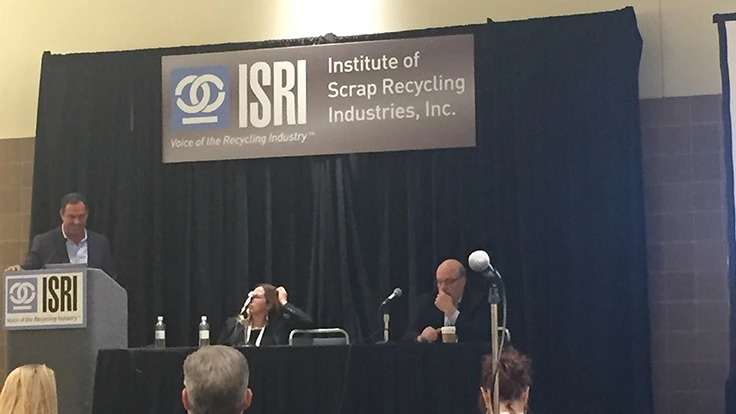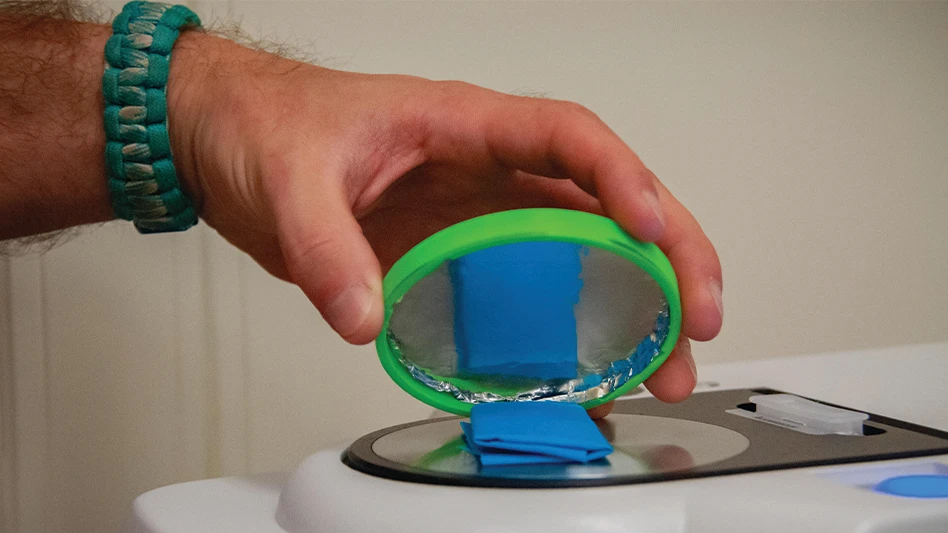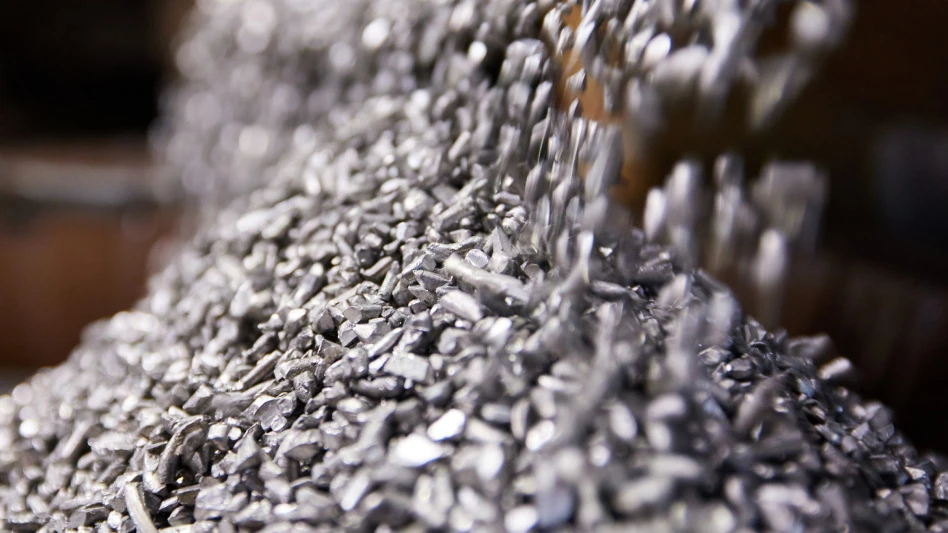
Pictured above, from left: Jon Stephens, Maite Quinn and and Steve Alexander were speakers in the ISRI2017 session Improving Plastic Quality by Implementing a Bale Audit Procedure.
Plastics are not unlike other recyclables when it comes to quality: the cleaner the bale, the more money that can be made. Speakers in several sessions that focused on plastics recycling at ISRI2017, the annual convention of the Washington-based Institute of Scrap Recycling Industries (ISRI), which took place in New Orleans April 22-27, discussed ways recyclers can improve plastic quality, shared tips on how to reduce bale rejections and offered options to integrate unconventional fillers in plastics for profit.
In the Creating a Better Bale and Understanding Plastic Resin Identification session, speaker Dave Schneebaum, CEO of Snowtree Consulting and Recycling Inc., said China currently is accepting less plastics “because they want quality.” Schneebaum was referencing that country’s January 2017 implementation of its “National Sword” campaign. The border control regimen, according to China’s General Administration of Customs (GAC), is designed to crack down on smuggling and importing of “foreign waste” into the country.
Schneebaum provided an overview of the different plastic polymers Nos. 1 through 7 and moves to make to reduce rejections of bales. “Clear, dried and [stored] indoors gets the most money,” he said when detailing the state of baled plastics.
In reference to National Sword, he said, “Six to eight months from now, it has to be cleaner for a sellable product.”
Jon Stephens, executive vice president of Houston-based Avangard Innovative, said in the session Improving Plastic Quality by Implementing a Bale Audit Procedure that like China’s Green Fence initiative in 2014, the National Sword campaign will result in higher recovery and better bale quality.
“[Companies] will need to do their bale audits and it will force the marketplace to produce a better bale quality,” Stephens said.
“At the end of the day, it will eventually help us,” he added. “But … material will be turned away,” Stephens acknowledged.
He cited the use of ‘smart’ technology, specifically Avangard’s Natura Smart Technology, as one route to improve plastic bale quality. This advanced technology also offers transparency, he said. By retrofitting balers with cameras, for example, recyclers can take photos of material as documentation. In addition, uploading data to the cloud can produce reports that weren’t possible before. This real-time reporting is the “new wave” in the sector today, Stephens said.
“With smart technology, we can look at every single bale that is loaded on every truck,” he said. “We understand clients’ habits better.”
However, “There’s still not enough companies using the technology available to sort this material,” Stephens added.
Beyond this, there is a need for more input from packaging engineers, speakers said.
A lot of design engineers don’t know what a material recovery facility (MRF) is, said Steve Alexander, president of The Association of Plastic Recyclers (APR), Washington.
Another speaker in the plastic quality and bale auditing session, Alexander provided an overview of the association’s APR Design Guide for Plastics Recyclability. The goal of the guide is to have packaging designed that is compatible with the recycling infrastructure. It outlines steps for packaging and design engineers to consider the implications of new products or containers in the recycling process.
Alexander said the Design Guide is “probably the most comprehensive tool” available for creating a package that is compatible with recycling.
Design engineers often don’t realize their packaging is a contaminant for recycled material, he said, and explaining the reasons why can prove beneficial.
“Try to tell brand owners [they] can create a package that is recyclable,” Alexander offered. “They don’t know how the process works,” he said, referencing design engineers and their knowledge of how MRFs work.
The need for thoughtful design from engineers is a point all plastics recyclers should be making, said Chris Surbrook, new business development, Midland Compounding & Consulting Inc., Midland, Michigan.
Surbrook spoke in the session Integrating Unconventional Fillers in Plastic Applications, where he outlined four separate case studies: sawdust-filled polypropylene (PP) materials; paper shavings in polyethylene (PE); putting scrap paint in PP; and the use of crumb rubber in plastics.
Rob Banning, another speaker in that session and managing partner of St. Louis-based Trimax LLC, outlined new markets and technologies for finished goods using Thrive composites, which use cellulose fibers to reinforce various plastics.
Owned by International Paper, Memphis, Tennessee, Thrive is a tree-based composite that has a much lower tendency for warping, is lightweight and faster to mold, Banning said.
“What an opportunity for those of you in the recycling industry,” he said.
Banning said the opportunity for economic value lies in the fact that this application requires a lower heat, and ultimately less energy, to produce. Thrive can be used in auto parts, office furniture, kitchenware, appliances and other goods. Cellulose fiber that has been pulled from trees, Thrive is the same fiber that is found in diapers, he said, adding that there isn’t another filler or additive like it.
“This offers a tremendous opportunity for plastics,” Banning said. “It more than triples the profit of parts manufacturers.”
No matter the plastic type, auditing bales is important to maintain quality. Session moderator Maite Quinn, business development and marketing manager for Brooklyn, New York-based Sims Municipal Recycling (SMR), said MRFs, reclaimers and municipalities are typically in charge of audits. SMR is a division of New York City and Sydney-based Sims Metal Management (SMM).
For SMR, simply taking a look at the bale is not good enough.
“We never eyeball this stuff,” Quinn said. She explained how the company cuts a corner from each bale and also uses a template to record findings when looking at recovery and value.
Investing in recycling—from design to infrastructure, will help to improve the quality of baled plastics, speakers said.
“How do we improve infrastructure to get better bale quality?” Stephens asked.
ISRI2017 was in at the Ernest N. Morial Convention Center in New Orleans April 22-27, 2017.
Latest from Recycling Today
- APR launches Recycling Leadership Awards
- Private equity firm announces majority investment in Sprout
- Author predicts spike in silver’s value
- SWANA webinar focuses on Phoenix recycling collaboration
- Domestic aluminum demand up through Q3 2024
- IntelliShift honored at IoT Breakthrough Awards
- Ace Green Recycling finalizes plans for battery recycling site in India
- Ambercycle, Benma partner to scale circular polyester





